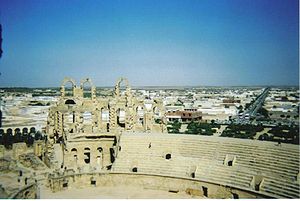El Djem
El Djem قصر الجمّ | |
|---|---|
 The town seen from the ruins | |
| Country | |
| Governorate | Mahdia Governorate |
| Population (2004) | |
| • Total | 18,302 |
| Time zone | UTC1 (CET) |
El Djem (Arabic: قصر الجمّ; Latin Thysdrus) is a town in Mahdia Governorate, Tunisia, population 18,302 (2004 census). It is home to some of the most impressive Roman remains in Africa.
History

The city was built, like almost all Roman settlements in Tunisia, on former Punic settlements. In a less arid climate than today's, Roman Thysdrus prospered especially in the 2nd century, when it became an important centre of olive oil manufacturing for export. It was the seat of a Christian bishop - which is still occupied by a titular Roman Catholic bishop today.
By the early 3rd century AD, when the amphitheatre was built, Thysdrus rivalled Hadrumetum (modern Sousse) as the second city of Roman North Africa, after Carthage. However, following the abortive revolt that began there in 238 AD, and Gordian I's suicide in his villa near Carthage, Roman troops loyal to the Emperor Maximinus Thrax destroyed the city. It never really recovered.
In more recent times the amphitheatre was used for filming some of the scenes from the Oscar winning film Gladiator starring Russell Crowe.
Sights
Amphitheatre
This section needs expansion with: To expand the page from French Wikipedia article. You can help by adding to it. (April 2010) |


El Djem is famous for its amphitheatre (often incorrectly called "a coliseum"), capable of seating 35,000 spectators. Only Rome's Colosseum (about 45,000 spectators) and the ruined theatre of Capua are larger. The amphitheatre at El Djem was built by the Romans under proconsul Gordian, who was acclaimed Emperor at Thysdrus, around 238 and was probably[citation needed] mainly used for gladiator shows and chariot races (like in Ben-Hur). It is also possible that construction of the amphitheatre was never finished.
Until the 17th century it remained more or less whole. From then on its stones were used for building the nearby village of El Djem and transported to the Great Mosque in Kairouan, and at a tense moment during struggles with the Ottomans, the Turks used cannons to flush rebels out of the amphitheatre.
The ruins of the amphitheatre were declared a World Heritage Site in 1979.
Others
| UNESCO World Heritage Site | |
|---|---|
 | |
| Criteria | Cultural: iv, vi |
| Reference | 38 |
| Inscription | 1979 (3rd Session) |
Drifting sand is preserving the market city of Thysdrus and the refined suburban villas that once surrounded it. The amphiteatre occupies archaeologists' attention: no digging required. Some floor mosaics have been found and published, but field archaeology has scarcely been attempted.
In the world of writing materials, Thysdrus lay in the Empire of Papyrus, which preserves remarkably well if kept as dry as at El Djem..
World War II
During World War II a major military airfield was located near El Djem, used first by the German Luftwaffe. It was attacked on numerous occasions and later used by the United States Army Air Force Twelfth Air Force as a transport field. There are few, if any, remains of the airfield today with the land being returned to agricultural uses outside of the city.
See also
External links
- Ancient Places TV: HD Video of El Djem amphitheatre
- El Jem Photo Gallery
- Roman mosaics in Tunisia
- Amphitheater of El Djem
